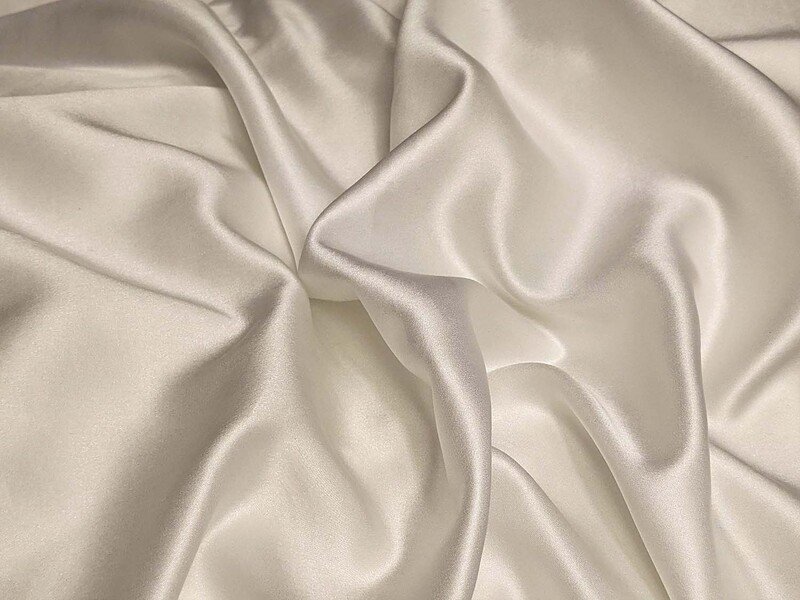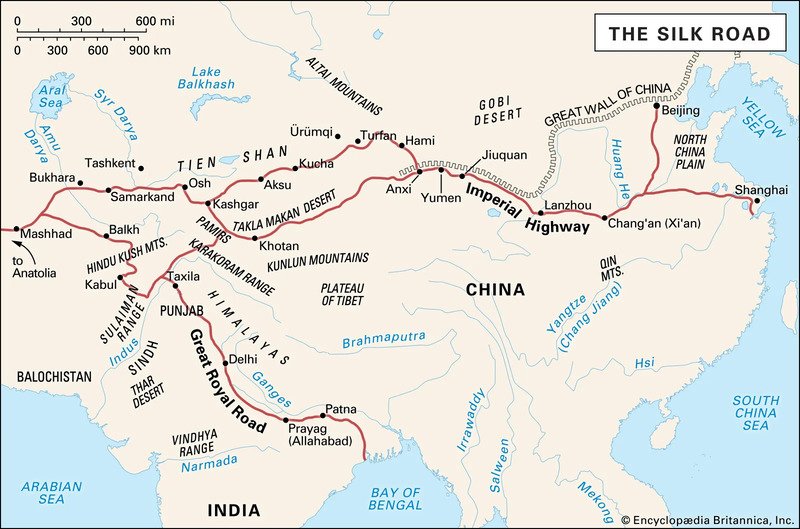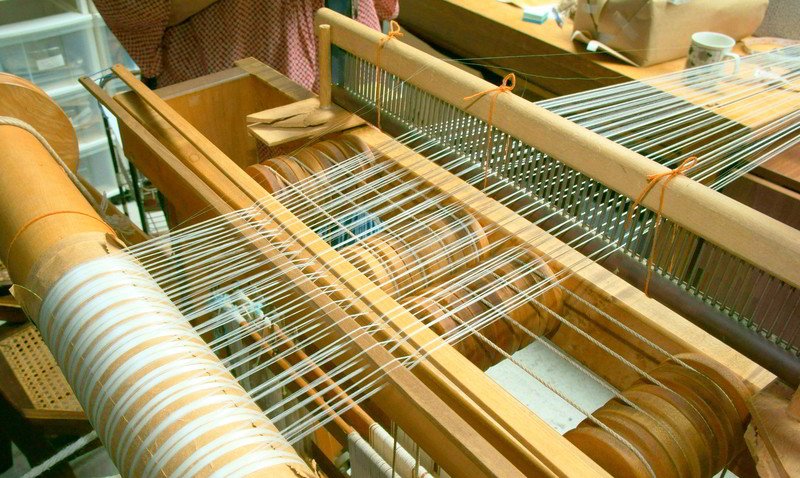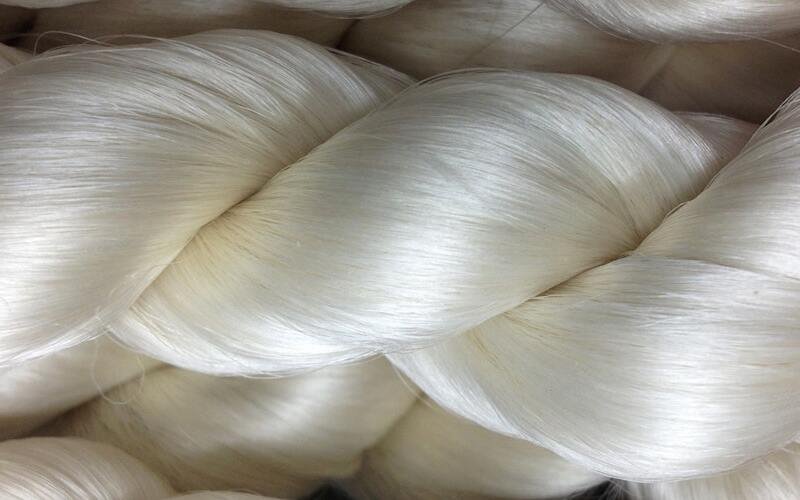What Is Silk? Guide To The Queen Of Fabrics, Origins And Uses
Have you ever touched a piece of clothing that felt incredibly soft and smooth? It might have been silk! Silk is a special, beautiful natural fabric that people have loved for thousands of years. Simply put, silk is a natural cloth made by tiny creatures called silkworms. In this article, we’ll explore what silk is, where it comes from, how it’s made, and why it’s so popular.
1. The composition of silk
1.1. The silkworm and its cocoon
The journey of silk begins with a small creature: the silkworm. Most silk we use comes from a type of caterpillar called the Bombyx mori silkworm. This silkworm isn’t born knowing how to make fabric; it spins a protective home for itself called a cocoon (a silky case spun by a silkworm larva for protection during its pupal stage).
Imagine the silkworm building a tiny, silky house for itself, using just one super-long piece of thread! This single, incredibly long thread from the cocoon is the raw material that becomes the silk fabric we know.

1.2. The main ingredients
This amazing silk thread is a natural fiber (a fiber produced by plants or animals), and it’s made of protein. This is a bit like the protein that makes up your hair, but the silk protein makes the thread very fine and amazingly strong for how light it is. The main protein in silk is called fibroin. Fibroin is what gives silk its strength and soft, smooth feel.
There’s another protein called sericin. Think of sericin as a natural glue that the silkworm uses to hold the cocoon’s thread together. When we make silk fabric, most of this sericin is washed away. It’s the fibroin that remains, giving silk its wonderful qualities.
2. The story of silk
2.1. Where silk began
Silk was first discovered and made in ancient China, many thousands of years ago. A popular story says that an empress in China, named Leizu, discovered silk when a silkworm cocoon accidentally fell into her hot tea, and she saw the strong, fine thread unravel. For a very long time, China kept the secret of how to make silk. This made silk very rare and extremely valuable, like gold.
2.2. The Silk Road
Later, silk started to travel from China to other parts of the world, like the Middle East and Europe. It was carried along a famous ancient trading route called the Silk Road. Silk was one of the most important and precious goods traded on this route. Its beauty and rarity made it highly desired by kings, queens, and wealthy people in many lands.

2.3. Silk today: still a special fabric
Even now, with so many new, man-made fabrics available, silk is still seen as a special, beautiful, and often luxurious material. Its unique shine, softness, and comfortable feel mean it continues to be loved and used for wonderful clothes and items.
3. How do we get silk?
The whole process of raising silkworms and making silk is called sericulture (the cultivation of silkworms for silk production). It’s like farming for silk! It involves several careful steps.
3.1. Step 1: Raising silkworms
The journey starts with tiny silkworm eggs. When these eggs hatch, small larvae (the silkworms) emerge. These tiny silkworms are fed a lot, and they eat almost constantly. Their favorite food, and what most of them eat, is fresh mulberry leaves. They eat and eat, growing very quickly!
3.2. Step 2: Spinning the cocoon
After several weeks of eating and growing, the silkworms are ready to spin their cocoons. Each silkworm creates its cocoon from a single, continuous thread of liquid silk that comes from its body. This liquid silk hardens when it touches the air. It takes a few days for each worm to complete its snug, silky home.
3.3. Step 3: Getting the silk threads
Once the cocoons are complete, they are collected. To get the silk thread, the cocoons are usually placed in hot water. This softens the sericin (the natural glue) and makes it possible to find the end of the long thread.
The cocoons are carefully treated to get the long threads. The process of carefully unwinding this very long, single thread from each cocoon is called reeling (the process of unwinding silk filaments from cocoons).
Because a single silk thread is incredibly fine, several threads (often 5 to 8) from different cocoons are reeled together and gently twisted. This creates a thicker, stronger silk yarn that is ready to be woven into fabric. It’s like taking many tiny, delicate hairs and twisting them together to make one strong, usable string.

3.4. Step 4: Making silk fabric
The reeled silk yarn is then used to create silk cloth. This silk yarn is then woven on special machines called looms. Weaving (the process of forming fabric by interlacing threads) is the method of interlacing threads to create fabric.
The way the threads are woven can make the silk fabric look and feel different. Some weaves make silk shiny, others make it matte, and some make it light or heavier.
4. What makes silk feel so good and look so pretty?
4.1. Shiny and bright
One of the first things people notice about silk is its beautiful shine, often called ‘luster.’ This natural shimmer makes silk look very rich and elegant. The secret to this shine is the shape of the silk fiber. Each silk fiber is like a tiny triangle, a bit like a prism. When light hits these flat, triangular surfaces, it bounces off in a way that creates that special sparkle and sheen.
4.2. Smooth and soft
Silk is famous for feeling incredibly smooth and soft when you touch it. It glides over your skin. This smoothness makes silk very comfortable to wear, especially next to the skin, as it doesn’t usually scratch or irritate. It’s a truly gentle fabric.
4.3. Strength and durability
Even though silk looks and feels very fine and delicate, it’s actually surprisingly strong. For its thinness, silk is one of the strongest natural fibers you can find. It’s stronger than cotton or wool of the same thickness. However, it’s good to know that silk can lose some of its strength when it gets very wet, so it needs gentle handling during washing.

4.4. Other good things about silk
Silk has even more wonderful qualities:
- Gentle on skin (hypoallergenic): Silk is often a great choice for people with sensitive skin. Because it’s a natural protein and so smooth, it’s less likely to cause irritation or allergies. This is why it’s called hypoallergenic (unlikely to cause an allergic reaction).
- Good at soaking up moisture (absorbent): Silk can absorb a good amount of moisture (like sweat) without feeling damp or sticky. This helps you stay comfortable.
- Helps control temperature (temperature regulating / breathable): Silk is clever with temperature! It’s a breathable fabric (allows air to pass through), meaning air can flow through it. This helps you stay cool when the weather is warm. But it also has good insulating properties, so it can help keep you warm when it’s cool.
5. Understanding different silk types
You might be surprised to learn there isn’t just one type of silk! There are many different kinds. Some differences come from the type of silkworm, and others from how the silk threads are woven into fabric.
5.1. Mulberry silk
Mulberry silk is the most common type of silk you’ll find, and it’s usually considered the finest and highest quality. It comes from silkworms (the Bombyx mori kind) that are raised on farms and fed only the leaves of mulberry trees.
This careful diet helps them produce silk threads that are very round, fine, smooth, and naturally white or off-white in color before dyeing. Mulberry silk is known for its luxurious feel and consistent quality.
5.2. Wild silks
Besides Mulberry silk, there are also ‘wild silks.’ These come from silkworms that live in the wild, not on farms. These wild silkworms eat different kinds of leaves, not just mulberry. Some examples of wild silks are Tussah silk, Eri silk, and Muga silk.
Because their diet is different and they live in the wild, their silk can be a bit different too. Wild silks might feel a little rougher, or they might not be as shiny as Mulberry silk. They also often have more natural color variations, like light browns or yellows, before any dyeing.
5.3. Common silk fabrics
The way silk threads are woven together also creates different types of silk fabrics. Each fabric has its own special look and feel.
- Satin (Silk satin): Silk satin is very shiny and super smooth on one side, while the other side is dull (not shiny). It’s often used for fancy dresses, blouses, and luxurious items because of its beautiful gloss.
- Chiffon (Silk chiffon): Silk chiffon is a very light, thin, and almost see-through (sheer) fabric. It floats beautifully when it moves and is often used for scarves, delicate layers on dresses, or evening wear.
- Crepe de Chine: Silk Crepe de Chine has a soft, slightly bumpy or crinkled texture. It’s not as shiny as satin but drapes very well (hangs nicely). It’s a popular choice for blouses and dresses.
- Charmeuse: Silk Charmeuse is lightweight and very soft, with a very shiny front side (like satin) and a dull back. It drapes wonderfully and is often used for lingerie, elegant dresses, and blouses. It really flows.
6. What do we use silk for?
6.1. Clothes
Silk is very popular for making all sorts of beautiful clothes, especially for special occasions but also for everyday luxury. You’ll often find silk used for elegant dresses (like wedding gowns and evening dresses), stylish shirts and blouses, smart ties, colorful scarves, comfortable pajamas, and delicate underwear (lingerie).
People choose silk for clothes because it makes them look elegant and feel wonderful against the skin. Because silk clothes are often delicate, any labels attached to them, like brand labels or care labels, also need to be soft and smooth.
For example, smooth woven labels (labels made by weaving threads together, like on clothing necklines) or soft satin printed labels are often used so they don’t irritate the skin or damage the delicate silk fabric.
6.2. Things for your home
Silk isn’t just for wearing! It’s also used to make luxurious and beautiful things for our homes. You might find silk in bed sheets and pillowcases (people say silk pillowcases are good for your hair and skin!), elegant curtains or drapes, soft cushion covers, and other decorative items like wall hangings or lampshades.
6.3. Other uses
Beyond clothes and home items, silk has had other interesting uses. For example, some artists like to paint on silk fabric. In the past, because it’s so strong for its weight, silk was even used for things like parachutes. It was also sometimes used by doctors for stitches (sutures) because it’s a natural fiber.
7. Caring for your silk items
Silk is a special fabric, and with a little gentle care, it can stay beautiful for a long time. The most important tip: Always check the care label on your silk item first! Different types of silk and silk blends might need slightly different care.
7.1. Washing silk
- Hand washing is often best: Use cool or lukewarm water (not hot).
- Use a very mild soap: Look for soap made for delicate fabrics or silk. Avoid strong detergents or bleach.
- Be gentle: Don’t scrub or twist the silk too much.
- Don’t soak for too long: Just a few minutes is usually enough.
- Check for ‘Dry Clean Only‘: Some silk items, especially tailored ones or those with complex designs, might say ‘Dry Clean Only.’ If so, it’s best to take them to a professional cleaner.
7.2. Drying silk
- Do not wring or twist: Never twist or wring silk tightly to get water out, as this can damage the delicate fibers.
- Remove excess water gently: Lay the wet silk item flat on a clean, absorbent towel. Gently roll the towel and the silk item together, pressing softly to let the towel soak up extra water.
- Dry flat or hang carefully: Lay the silk item flat on another clean, dry towel or on a mesh drying rack. If you hang it, use a padded hanger so it doesn’t get marks on the shoulders.
- Avoid direct sun and heat: Dry silk in a shady spot, away from direct sunlight and direct heat (like radiators). Sun can fade the colors and weaken the silk fibers over time.
7.3. Ironing silk
- Use a low heat setting: Set your iron to a cool or low heat setting. Many irons have a specific ‘silk’ setting – use that if available.
- Iron when slightly damp: Silk is easiest to iron when it’s still a little bit damp, not completely dry.
- Iron on the ‘wrong’ side: Turn the silk item inside out and iron on the duller, back side (the ‘wrong’ side). This helps protect the shine on the front.
- Use a pressing cloth (optional but good): For extra protection, you can place a thin, clean cotton cloth (like a handkerchief) between the iron and the silk. This is called a pressing cloth.
- Don’t use steam directly (or test first): Sometimes direct steam can leave water spots on some silks. If you want to use steam, test on a hidden area first, or use the steam function through a pressing cloth.
8. Understanding ahimsa silk
In traditional silk making, the silkworm is usually inside the cocoon when the threads are collected. This means the worm doesn’t get to become a moth. For people who are concerned about this, there’s an alternative called ‘Ahimsa Silk’ or ‘Peace Silk.’ ‘Ahimsa’ is a word that means ‘non-violence’.
With Ahimsa silk, the cocoons are collected only after the moth has naturally hatched from the cocoon and flown away. This means the silkworm completes its life cycle and is not harmed in the process of getting the silk. This type of silk is an option for those who want silk made with a focus on animal welfare.
9. The enduring appeal of silk
So, as we’ve seen, silk is a truly amazing natural fiber that comes to us from the tiny silkworm. For thousands of years, and still today, people love silk for many reasons: its beautiful, natural shine; its incredibly soft and smooth feel against the skin; its surprising strength for such a fine material; and the way it makes things look and feel luxurious and special.
From ancient empresses to modern fashion, silk has always been a prized fabric, and its unique qualities mean it will likely be loved for a long time to come.
10. Your silk questions answered (FAQs)
10.1. Is silk expensive? Why?
Yes, silk is often more expensive than common fabrics like cotton or polyester. This is because making silk is a careful and time-consuming process. It involves raising silkworms and feeding them a special diet (lots of mulberry leaves), the delicate work of unwinding the very fine threads from many cocoons (it takes thousands of cocoons to make just one pound of silk), and carefully weaving these threads into fabric. Basically, it takes a lot of work and many cocoons to produce even a small amount of silk, which makes it more costly.
10.2. Is silk a natural or man-made fiber?
Silk is 100% a natural fiber. It comes directly from nature – it’s made by silkworms when they spin their cocoons. It’s not created in a factory using chemicals, like man-made (synthetic) fibers such as polyester or nylon.
10.3. What does silk feel like?
Silk feels incredibly smooth, soft, and often a little cool when you first touch it. It glides beautifully over the skin and isn’t usually scratchy or rough. Many people describe it as feeling luxurious and very comfortable.
10.4. Is silk good to wear in summer?
Yes, silk can be very comfortable to wear in the summer. It’s a natural, breathable fabric, which means air can pass through it, helping you to stay cool. It can also absorb some moisture (like sweat) without feeling wet, which adds to comfort in warm weather. Lightweight silks like chiffon or crepe de chine are especially good for summer.
10.5. How can I tell if something is real silk?
- Look and feel: Real silk usually has a special shine (luster) that changes as the light hits it from different angles. It should feel very smooth and luxurious.
- Label: The easiest way is to check the care label – it should say “100% Silk” or specify the silk content.
- Price: If a large item advertised as silk is very, very cheap, it might be a synthetic look-alike. Real silk production is costly.
- Burn test (caution): Experts sometimes do a “burn test” with a single loose thread (if available without damaging the item). Real silk burns slowly, smells like burning hair, and leaves a brittle, crushable ash. Many synthetic fabrics melt, smell like burning plastic, and leave a hard bead. However, this test can be dangerous, can damage the item, and is NOT recommended for you to do at home on a finished product.
Explore more:
From its ancient origins to its modern-day luxury, silk is a fabric that demands care and attention to detail. This extends to every element of a silk garment, including the branding. A soft, well-made label is essential to preserve the comfort and quality of silk clothing.
At Packlove, we specialize in creating custom labels and tags that complement the world’s finest fabrics. We hope this guide has deepened your appreciation for the wonderful world of silk!






















